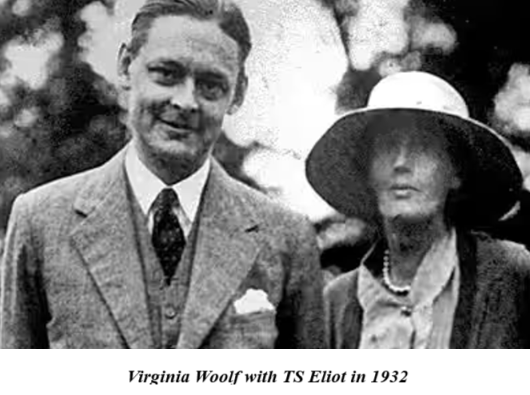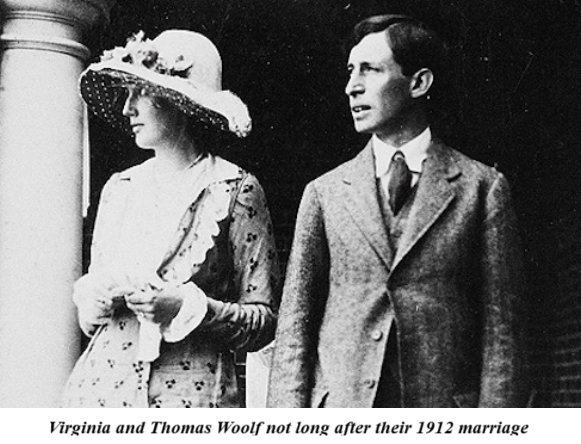Dear Leonard,
I am so sorry and anxious to hear that Virginia is ill again. I pray that it is not serious, and hope to hear of her progress. Do give her my sincere sympathy: we know what constant illness is, and I think very few people do. I hope that I shall see you both soon.
Sincerely yours
T.S. Eliot (6 May 1922)
The influenza that raged in the latter half of 1921 and continued through the early part of 1922 engendered fears of a repeat of the “Spanish Flu” which had afflicted so many a few years earlier. This recent strain had already taken some prominent scalps, Pope Benedict XV and the explorer Ernest Shackleton being but two. Literary circles were not exempt from infection. Eliot himself had contracted it, so too Joseph Conrad. D.H. Lawrence would develop symptoms just before Christmas 1921, but in true Lawrentian fashion had figured, “I hate Christmas anyhow.”
Virginia Woolf displayed symptoms of the virus in the first week of 1922. In that week the Times had reported 151 deaths in London alone, from what it had dubbed the “Winter Sickness”. By the end of March, a death figure of 16,388 was published with the proviso that the true figure was probably closer to 30,000, if deaths due to complications from pre-existing conditions were taken into account. As Eliot’s note indicates, Woolf was still ill in May and this warranted concern.
Barry Gillard’s essays appear regularly in Quadrant.
Click here to subscribe
She was no stranger to being unwell. Indeed, a fortnight after developing the influenza symptoms and having just turned forty, she had grimly joked, in a letter to E.M. Forster, that she should really be regarded as only around thirty-five since, by her own reckoning, illness had removed her from participation in the world for as much as five years.
In 1895, at the age of thirteen, she had suffered a mental breakdown after the death of her mother, Julia Stephen, and at nineteen had asked of her recently widowed brother-in-law: “Jack, do you think I shall ever commit suicide?” While one imagines Jack had answered in the negative, Virginia did throw herself from a window (albeit from a safe enough height) after the death of her father Sir Leslie Stephen in 1904. Her illness on this occasion was severe enough to lead her to claim that the birds in the family’s shrubbery were communicating in Greek and that the nearby azaleas were harbouring a foul-mouthed King Edward VII.
A period of relative calm followed, during which she married Leonard Woolf in 1912. Soon after this, however, she suffered further bouts of depression, constant severe headaches, episodes of insomnia and an aversion to food so severe that at one stage she steadfastly refused to eat. At her lowest point she attempted suicide by ingesting ten times the  prescribed dosage of the barbiturate Veronal and, according to Lytton Strachey, an “immense quantity of an even more dangerous drug—Medinal”.
prescribed dosage of the barbiturate Veronal and, according to Lytton Strachey, an “immense quantity of an even more dangerous drug—Medinal”.
To return to 1922. During March, Woolf described the flu, in a letter to Elizabeth Bowen, as “foul, it leaves one like a watch that doesn’t tick”. Three months later, she recorded in her diary:
These, this morning, [are] the first words I have written—to call writing—for 60 days; and those days spent in wearisome headache, jumping pulse, aching back, frets, fidgets, lying awake, sleeping draughts, sedatives, digitalis, going for a little walk, and plunging back into bed again—all the horrors of the dark cupboard of illness once more displayed for my diversion. Let me make a vow that this shall never, never, happen again: and then confess that there are some compensations. To be tired and authorised to lie in bed is pleasant … I feel that I can take stock of things in a leisurely way. Then the dark underworld has its fascinations as well as its terrors.
Part of her slow recovery was spent in immersing herself in the works of Marcel Proust and the recently published and much publicised Ulysses by James Joyce. She was smitten by the former and dismissive of the latter:
Proust so titillates my own desire for expression that I can hardly set out the sentence. Oh if only I could write like that! I cry. And at the moment such is the astonishing vibration and saturation and intensification that he procures—theres [sic] something sexual in it—that I feel I can write like that, and seize my pen and then I can’t write like that. Scarcely anyone so stimulates the nerves of language in me: it becomes an obsession …
On Joyce, her initial reaction was: “I can’t see what he’s after … I did my level best”. And on further reflection:
I … have been amused, stimulated, charmed, interested by the first 2 or 3 chapters—to the end of the Cemetery scene; & then puzzled, bored, irritated, & disillusioned as by a queasy undergraduate scratching his pimples. And Tom [Eliot], great Tom, thinks this on a par with War and Peace! An illiterate underbred book it seems to me: the book of a self-taught working man, & we all know how distressing they are, how egotistic, raw, striking, & ultimately nauseating.
One suspects she was thinking here of the self-taught character Leonard Bast, in Forster’s Howards End (1910), before wondering: “When one can have cooked flesh, why have it raw?” and adding: “But I think if you are anaemic, as Tom is, there is glory in blood … I do not compromise my critical sagacity, I plant a stick in the ground to mark page 200.”
In contrast, having devoured what was then available of Proust’s seven-volume Á la recherche du temps perdu (the final three volumes being published after 1922), she was left starstruck and pondered, “Well, what remains to be written after that?”
Woolf’s answer was the short story “Mrs Dalloway in Bond Street” (1922). While it is a story which at once doffs its hat to Proustian memory-triggers—in this instance “A leaf of mint brings it back; or a cup with a blue ring”—curiously, however, in style it owes more to Joyce.
Mrs Clarissa Dalloway has stepped out onto London streets to buy herself some gloves. Her journey is expressed as an interior monologue in which—in the manner of Joyce’s Leopold Bloom—she remembers, observes, passes judgment and reflects. She stops momentarily to speak to a man she has known since childhood, before moving on. The bustle of being outdoors is exhilarating. Big Ben has just struck the morning hour of eleven:
Omnibuses joined motor cars: motor cars vans: vans taxicabs, taxicabs motor cars—here was an open motor car with a girl, alone. Up till four, her feet tingling, I know, thought Clarissa, for the girl looked washed out, half asleep in the corner of the car after the dance … Another motor car passed. How utterly unattractive! Why should a girl of that age paint black around her eyes? And a young man, with a girl, at this hour, when the country— The admirable policeman raised his hand and Clarissa acknowledging his sway, taking her time, crossed, walked towards Bond Street.
The gloves are purchased. While Mrs Dalloway waits impatiently for the saleswoman to attend to the particulars of the sale, there is a “violent explosion in the street outside”—one of the motor cars has evidently backfired—and while the shop assistants cower behind the counters, amidst the confusion that entails, Clarissa remains unruffled and suddenly remembers the name of the other customer in the shop. It is the story that critics generally accept as marking a new beginning for Woolf’s fiction. Earlier, she had written in her diary:
I have made up my mind that I’m not going to be popular, & so genuinely that I look upon disregard or abuse as part of my bargain. I’m to write what I like; & they’re to say what they like.
In another entry she wrote:
There’s no doubt in my mind that I have found out how to begin (at 40) to say something in my own voice; & that interests me so that I feel I can go ahead without praise.
The short story reached a fuller development in the novel Mrs Dalloway (1925). Here, “Mrs Dalloway said she would buy the flowers herself”: and unmistakeably Joycean again, it follows, as Ulysses does, the events of one June day, in this instance Wednesday June 13, 1923. The principal character is followed from morning to late in the evening, by which time she has hosted a large formal party. Fifty-two years old, with whitened hair and a “heart, they said, affected by influenza”, Clarissa Dalloway’s mind, throughout the day, delves back to the year 1889 when she was eighteen. Two important characters from this period will be present at the party, one invited and one not. Running parallel to this is the tale of Septimus Warren Smith, a returned serviceman from the Great War. He is suffering from “shell shock” and has suicidal thoughts. In a park he hears a sparrow sing “piercingly in Greek words”. At home he imagines he hears people talking on the other side of the bedroom walls. His wife has an arduous time of it:
He would argue with her about killing themselves; and explain how wicked people were; how he could see them making up lies as they passed in the street. He knew all their thoughts, he said; he knew everything. He knew the meaning of the world, he said.
While the writing of the Septimus part was difficult for Woolf—“The mad part tries me so much, makes my mind squint so badly that I can hardly face spending the next weeks at it”—her diaries often acknowledge what she saw as the potential literary benefits of being unwell. “In illness words seem to possess a mystic quality,” she proposed, “the police are off duty.”

T.S. Eliot would conclude similarly. Having written “What the Thunder Said”, the fifth and final section of The Waste Land (1922), while undergoing treatment for nervous collapse, he had been astounded to find that he had managed its completion in one afternoon and without corrections. He later reflected in his essay “The Pensées of Pascal” (1931):
it is a commonplace that some forms of illness are extremely favourable, not only to religious illumination, but to artistic and literary composition. A piece of writing meditated, apparently without progress, for months or years, may suddenly take shape … I have no word to say for the cultivation of automatic writing as the model of literary composition; I doubt whether these moments can be cultivated by the writer; but he to whom this happens assuredly has the sense of being a vehicle rather than the maker … you may call it a temporary crystallization of the mind.
Woolf’s own inquiry into the symbiotic relationship between illness and creative insight was contained in the essay “On Being Ill”, which Eliot published in his Faber-financed literary journal, the Criterion, in January 1926. Here, she speaks to the benefits of being withdrawn from the world, alone with only one’s thoughts and the view through the sickroom window. She finds it perplexing that “illness has not taken its place with love, battle and jealousy among the prime themes of literature”, and while naming Proust and Thomas de Quincey (Confessions of an English Opium Eater, 1821) as possible exceptions—she seemingly is unaware of the existence of the German publication of Thomas Mann’s The Magic Mountain in 1924—the essay predicts the need for a new genre of writing. In our own time this is a form now taken for granted and sometimes referred to as pathography: perhaps its most extreme example being Jean-Dominique Bauby’s The Diving-Bell & the Butterfly (1997), an account of Bauby’s experience of “Locked-In Syndrome” as a result of a massive stroke.
Echoing Friedrich Nietzsche’s questioning as to whether words can adequately express all realities, Woolf argued that while they served admirably in transmitting the innermost thoughts of a Hamlet or King Lear, it seemed even the most erudite of us may find our normal language fail us when asked to verbalise our physical ailments. Sardonically, she suggests that it may not only be a new language that is required for a new literature but a new cast of characters and emotions:
love must be deposed by a temperature of 104; jealousy give place to the pangs of sciatica; sleeplessness play the part of the villain, and the hero become a white liquid with a sweet taste … one of whose names is Chloral.
Nietzsche himself—and at a time when he was self-medicating with large doses of chloral hydrate—employed the word Neuschmeeken (new tasting) to describe the insights opened up to him through his regular bouts of ill health. Though these bedridden periods were described by him as initially being a descent into hell, in recuperation he became aware of fresh philosophical problems which could be approached with a new-found zest. His biographer Sue Prideaux interprets it thus: “His mental pattern was that of waves breaking restlessly on the shore, ever advancing, ever retreating, caught in the ghastly impetus of perpetual motion from which there could be no retreat.”
There are moments in Woolf’s most experimental novel, The Waves (1931), where the character, Neville, feels himself to be a real poet. These are rare instances wherein he feels “the familiar rhythm; words that have lain dormant now lift, now toss their crests, and fall and rise, and fall and rise again”. For Neville, however, these episodes end as rapidly as they come on. “Words and words and words, how they gallop”, for there is, he says, “some flaw in me—some fatal hesitancy, which, if I pass it over, turns to foam and falsity”.
Woolf suffered another lingering bout of influenza in February 1940, at a time when she and her husband had become pessimistic regarding the outcome of the war. By May the two were considering suicide. Being a Jew had made Leonard especially fearful of an England under Nazi control. In his autobiography he speaks of having seen a photograph:
of a Jew being dragged by storm troopers out of a shop in one of the main streets in Berlin; the fly-buttons of the man’s trousers had been torn open to show that he was circumcised and therefore a Jew … In this photograph what was even more horrible was the look on the faces of the respectable men and women, standing on the pavement, laughing at the victim.
Early the next year, Leonard’s diary recorded “V.n.w”, his shorthand for “Virginia not well”. Medical intervention proved pointless in this instance and on March 28, 1941, Virginia wrote a final letter to her husband expressing the certainty that she was “going mad again”. She said she was hearing voices and found concentration on any task impossible. The letter thanked Leonard for his patience and understanding, and closed: “I don’t think two people could have been happier than we have been. V.”

Leaving the letter on the sitting-room mantel, Virginia then walked through marshland and into the nearby river. She had already placed a large stone in a pocket of the coat she was wearing. She had been, as Michael Holroyd so aptly put it, “a connoisseur of feeling rather than a lover of life”.
“On Being Ill” was not the first treatise on illness to be written by a member of the celebrated Stephen family. Julia (then Duckworth), widowed by her first husband, and with three children to support, had turned to nursing to earn a living before remarrying. As Mrs Stephen, not only would she cite Florence Nightingale as an ideal role model for her Stephen daughters, Vanessa and Virginia, she would also publish Notes from Sick Rooms (1883).
While her literary daughter would become an advocate and major contributor to Modernist literature, Stephen’s own book concerned itself with pragmatic hints regarding the proper care for those indisposed by sickness. The work is adamant that the devil is in the detail when a patient’s comfort is at stake. On crumbs in the bed, it declares: “The torment of crumbs should be stamped out of the sick bed as if it were the Colorado beetle in a potato field.”
Barry Gillard, a frequent contributor on literature and history, lives in Geelong.
 Sign In
Sign In 0 Items (
0 Items ( Search
Search









Undernourished by Never-bred.
Thanks Barry. Seems like she would have been a rather strange, even neurotic woman in real life, with a very low immune system, and I would suggest similar sex appeal….. to men anyway.
Her Uncle ( I think ) James Fitzjames Stephen seems to have had a more sound mind and physical system, if his book ‘Liberty, Equality, Fraternity critiquing J.S Mill’s ‘On Liberty’ is anything to go by.